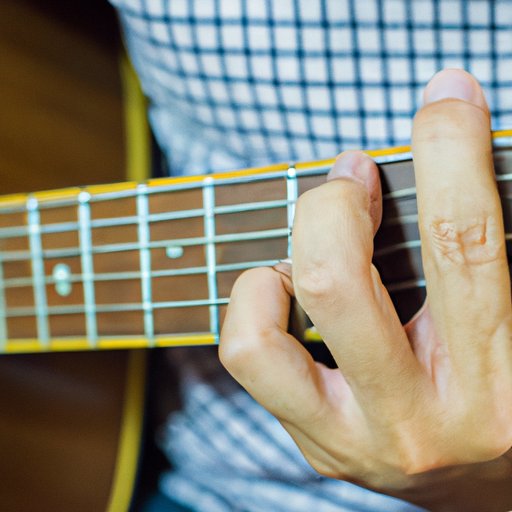Introduction
The purpose of this article is to provide you with a comprehensive guide to playing the guitar. We will cover everything a beginner needs to know, from the basics of chord progressions and strumming patterns to more advanced techniques like fingerpicking and tone. We understand that learning how to play the guitar can be challenging, but with the right resources and guidance, it can also be incredibly rewarding.
A Beginner’s Guide to Basic Guitar Chords and Strumming Patterns
If you’re just starting to learn how to play the guitar, you’ll want to start by learning the basics chords and strumming patterns. Chords are the building blocks of music, and strumming patterns are the rhythm that gives the chords their melody.
To begin, it’s best to learn the most commonly used chords, such as G, C, D, E, A, and F. These chords form the basis of many popular songs and are relatively easy to play. You can learn these chords by using chord diagrams or watching video tutorials. Once you’ve mastered a few basic chords, you can start learning full songs and practicing different strumming patterns to improve your timing and rhythm.
Learning How to Read Guitar Tabs: A Step-by-Step Tutorial
Guitar tabs are a form of musical notation that makes it easy to learn how to play songs on the guitar. Tabs show you how to play specific songs by indicating which frets to press on which strings. Once you’ve learned how to read tabs, you can easily learn new songs by finding tabs online and practicing them at home.
To begin reading tabs, start by finding a tab for a song you want to learn. Look for the tab’s number system, which shows which frets to press on which strings. Then, practice playing each note in the tab slowly, making sure to match the timing and rhythm of the song. With practice, you’ll be able to quickly and easily read tabs and learn new songs.
Mastering Fingerpicking Techniques for Acoustic Guitar
Fingerpicking is a technique often used on acoustic guitars that creates a more complex and intricate melody. Fingerpicking involves using your fingers to pluck the strings instead of using a pick. To begin, start by learning a few basic patterns, such as the Travis picking pattern or the clawhammer technique. With practice, you’ll be able to incorporate fingerpicking into your playing and create a more dynamic sound.
Getting Started with Electric Guitar: Amps, Effects, and Tone
If you’re interested in playing electric guitar, there are a few things you’ll need to know. Electric guitars require an amp to amplify the sound, and there are many different types of amps and effects you can use to create different tones. To begin, start by choosing an amp that is appropriate for your playing style and music genre. Then experiment with different effects pedals to create different sounds and tones.
Tips for Practicing and Developing Your Guitar Skills at Home
Consistent practice is vital to improving your guitar skills. However, it can be challenging to stay focused and motivated when practicing at home. Start by creating a dedicated practice space free from distractions, and set achievable goals for each practice session. Consider recording yourself playing and listening back to identify areas where you need to improve. Celebrate your progress and enjoy the journey of learning to play the guitar.
Playing Guitar with Others: Joining a Band or Starting a Jam Session
Playing with others is a great way to improve your guitar skills and have fun. Whether you’re joining a band or starting a jam session with friends, playing with others provides an opportunity to practice playing in sync with others and learn new techniques. If you’re interested in joining a band or finding other musicians to play with, consider attending local open mic nights or posting a message on social media to connect with other musicians in your area.
Conclusion
Learning how to play the guitar is an exciting journey filled with challenges and rewards. By following these tips and techniques, you can improve your skills and develop your own unique sound. Whether you’re just starting out or have been playing for years, there’s always something new to learn. Keep practicing, stay motivated, and enjoy the process of learning to play the guitar.
Additional Resources
For more information and resources on learning how to play the guitar, check out these websites:
